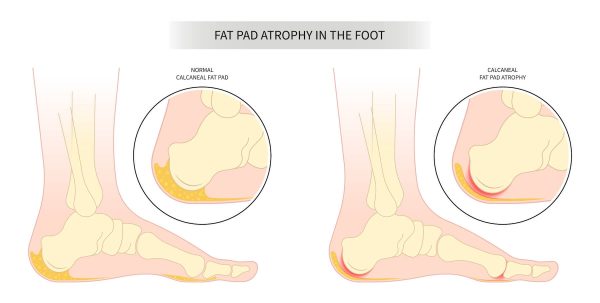Dropping extra fat can be a good thing, but your tender toes need the fat pads on your heels and balls of your feet for stability and cushioning. These pads support your joints during activities like standing, walking, and running. Today, we’ll discuss fat pad atrophy, symptoms, and treatment options to keep your feet walking on clouds.
Foot Pad Atrophy
Foot pad atrophy is a condition in which fat is lost in the pads of your foot. This condition is also called:
- Foot fat pad atrophy
- Heel fat pad syndrome
- Heel fat pad atrophy

Although many of these alternative names refer to the heel pad, atrophy can occur in both the heel pad and the ball of your foot, resulting in a noticeable thinning of the fat pads. The symptoms typically worsen over time and are caused or exacerbated by:
- Aging
- Increased weight
- Injury to your heel
- Repetitive activities or sports
- Hard surfaces or unsupportive shoes
Heel Fat Pad Atrophy Symptoms
The main symptom of atrophy is a deep pain in the area, usually severe. Pain intensifies with added pressure to the heel. If you are experiencing heel pain, it’s best to get checked by a podiatrist, as heel pad atrophy often gets mistaken for plantar fasciitis.
Ball of Foot Fat Pad Atrophy Symptoms
Fat pad atrophy in the ball of your foot is similar to atrophy in the heel fat pad. Deep pain that intensifies with applied pressure is the key symptom. Depending on the cause of your condition, you may have atrophy of the heel and ball of your foot fat pads in one or both feet.
Fat Pad Atrophy Treatment Options
Mild cases of foot pad atrophy can be treated at home with conservative options, while more advanced cases may require treatment from your podiatrist.
Home Care for Foot Pad Atrophy
Small adjustments to your life can help reduce the pressure on your heel and alleviate pain. One way is through shoe supports that provide extra padding to the bottom of your feet.
Additionally, ice packs and rest can go a long way toward relieving pain for minor cases. If using ice packs, remember to keep a towel between your foot and the ice pack to avoid frostbite, and keep your ice sessions short — 20 minutes or less.
Podiatrist-led Treatment Options
To relieve severe pain, your podiatrist may offer you treatment in the form of:
Injectable Fillers
Injectable fillers – synthetic or natural — can help thicken your fat pads to reduce pain long-term.
Surgery
A surgery can be done that takes fatty tissue from another area of your body and uses it to replace the worn-down fat pads.
Depending on your medical history, the severity of your fat pad atrophy, and your personal preferences, you and your podiatrist can discuss how to reduce your symptoms effectively.
Foot Pad Atrophy Prevention Tips
The best treatment is prevention in the first place. While some conditions can contribute to your risk of having foot pad atrophy, there are things you can do to keep your foot pads happy.
During sports or activities that put stress on your feet, wear proper athletic shoes that have cushioned heels and arch supports. After these intense activities, give your feet some time to recover before doing more.
Maintaining a healthy weight reduces the stress on your ankles and— of course— the bottoms of your feet.
Always wear shoes when on uneven surfaces or hard terrain. Not only can this protect your fat pads from wear and tear, but it can also reduce your risk of fallen arches.
Get Relief From Foot Pad Atrophy at The Foot & Ankle Group
If your symptoms of foot pad atrophy are severe or keep coming back, we can help get you back up on your feet again. Schedule an appointment with The Foot & Ankle Group today.
Categorized in: Blog
Comments are closed